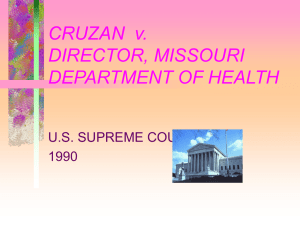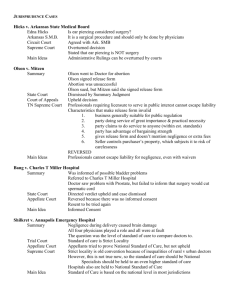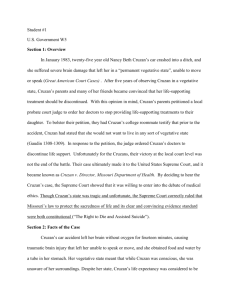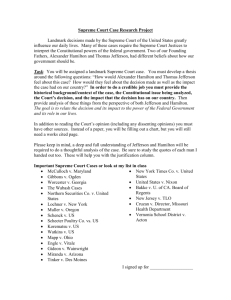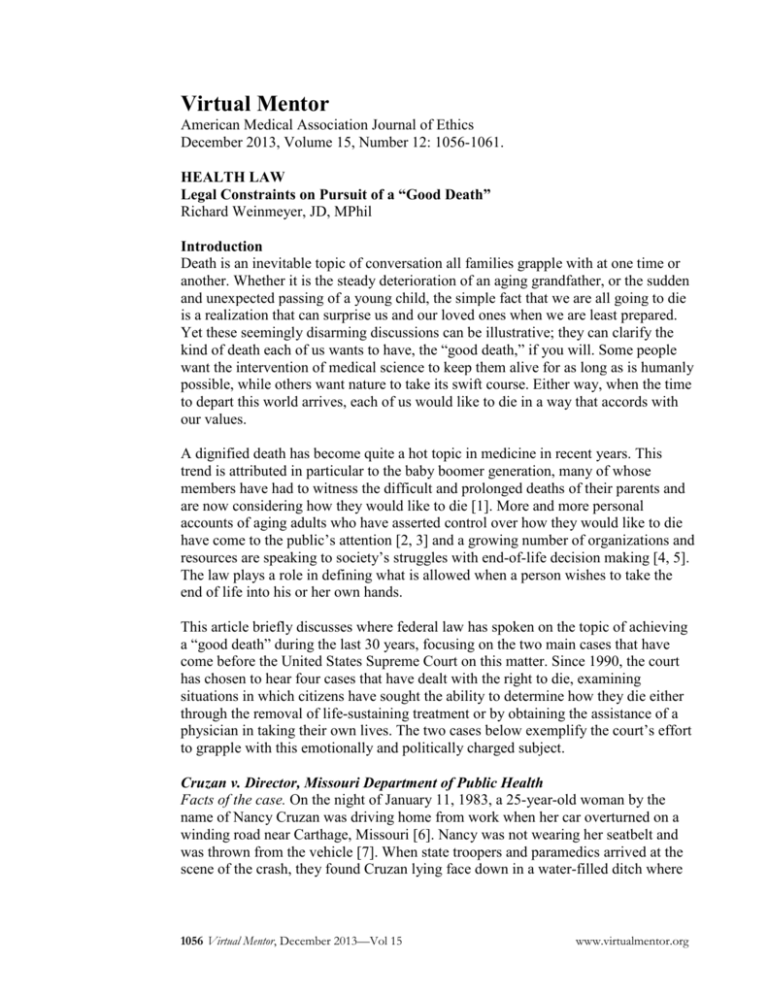
Virtual Mentor
American Medical Association Journal of Ethics
December 2013, Volume 15, Number 12: 1056-1061.
HEALTH LAW
Legal Constraints on Pursuit of a “Good Death”
Richard Weinmeyer, JD, MPhil
Introduction
Death is an inevitable topic of conversation all families grapple with at one time or
another. Whether it is the steady deterioration of an aging grandfather, or the sudden
and unexpected passing of a young child, the simple fact that we are all going to die
is a realization that can surprise us and our loved ones when we are least prepared.
Yet these seemingly disarming discussions can be illustrative; they can clarify the
kind of death each of us wants to have, the “good death,” if you will. Some people
want the intervention of medical science to keep them alive for as long as is humanly
possible, while others want nature to take its swift course. Either way, when the time
to depart this world arrives, each of us would like to die in a way that accords with
our values.
A dignified death has become quite a hot topic in medicine in recent years. This
trend is attributed in particular to the baby boomer generation, many of whose
members have had to witness the difficult and prolonged deaths of their parents and
are now considering how they would like to die [1]. More and more personal
accounts of aging adults who have asserted control over how they would like to die
have come to the public’s attention [2, 3] and a growing number of organizations and
resources are speaking to society’s struggles with end-of-life decision making [4, 5].
The law plays a role in defining what is allowed when a person wishes to take the
end of life into his or her own hands.
This article briefly discusses where federal law has spoken on the topic of achieving
a “good death” during the last 30 years, focusing on the two main cases that have
come before the United States Supreme Court on this matter. Since 1990, the court
has chosen to hear four cases that have dealt with the right to die, examining
situations in which citizens have sought the ability to determine how they die either
through the removal of life-sustaining treatment or by obtaining the assistance of a
physician in taking their own lives. The two cases below exemplify the court’s effort
to grapple with this emotionally and politically charged subject.
Cruzan v. Director, Missouri Department of Public Health
Facts of the case. On the night of January 11, 1983, a 25-year-old woman by the
name of Nancy Cruzan was driving home from work when her car overturned on a
winding road near Carthage, Missouri [6]. Nancy was not wearing her seatbelt and
was thrown from the vehicle [7]. When state troopers and paramedics arrived at the
scene of the crash, they found Cruzan lying face down in a water-filled ditch where
1056 Virtual Mentor, December 2013—Vol 15
www.virtualmentor.org
she exhibited no respiratory or cardiac function [8, 9]. Medical personnel were able
to restart her heart, but Nancy had stopped breathing for almost 15 minutes and as a
result suffered severe brain damage [8, 9]. A month after the accident, Cruzan’s then
husband consented to the implantation of a feeding and hydration tube to keep her
alive, although she was able to breathe without the assistance of a ventilator [8, 9].
Following the accident, all rehabilitative efforts failed, and Nancy remained in a
persistent vegetative state for years in a Missouri state hospital [9]. She experienced
occasional seizures, vomited, and, at times, opened and moved her eyes, yet she
displayed no cognitive activity [8]. Nancy had no documentation of her wishes for
medical treatment under such circumstances and had only mentioned in passing to a
roommate that she would never want to be a “vegetable” [10].
Struggles in state court. Nancy’s parents, believing in their hearts that their daughter
would never want to live life as she now did, sought and received authorization from
a state trial court to remove her feeding tube [11]. A divided vote by the Supreme
Court of Missouri reversed this decision, however [12]. The court did not find a right
under the Missouri Constitution that would support a person’s refusal of medical
treatment in every circumstance and doubted whether such a right even existed in the
U.S. Constitution [13]. Furthermore, the state supreme court, guided by the state’s
living will statute and policy favoring the “preservation of life,” found that the
evidence provided by her family did not offer “clear and convincing” proof of
Nancy’s wish to be removed from life-sustaining treatment [14]. The Cruzans
appealed their decision to the U.S. Supreme Court.
The Supreme Court’s review. The specific question before the Supreme Court was
whether the U.S. Constitution permitted Missouri to set an evidentiary standard
requiring surrogate decision makers to provide “clear and convincing” evidence that
a decisionally incapable person would wish to forgo life-sustaining treatment [15]. In
a five-to-four decision, the court found that it did. The Fourteenth Amendment’s due
process clause holds that no state “shall deprive any person of life, liberty, or
property, without due process of law” [16], and, through its examination of legal
precedent, the court determined that the ability to refuse medical treatment lies
within an individual’s right to liberty [17]. The court reached this conclusion through
its analysis of substantive constitutional freedoms supported by the Fourteenth
Amendment, which looked to whether the right in question was “deeply rooted in
[the] Nation’s history and tradition” [18].
In its review of existing law, the court found that time and again state courts had
come to recognize a right not to consent to treatment, just as there existed a right to
consent to treatment (e.g., the common-law doctrine of informed consent), and that
this spoke to a decisionally capable person’s ability to decline life-sustaining medical
care [15]. The majority determined, however, that the right of an individual to
decline life-saving medical interventions was not absolute and must be balanced
against the reasonable interests of the state in preserving life [19]. In the specific case
of Nancy Cruzan, despite the questionable evidence that she herself stated she would
not want to be kept alive, or her parents’ fervent belief that continuing artificial
www.virtualmentor.org
Virtual Mentor, December 2013—Vol 15 1057
feeding and hydration were not in her best interest, Missouri’s policy of preserving
life was held to be reasonable under the U.S. Constitution unless there was clear and
convincing evidence to the contrary [20]. As the court concluded in its opinion:
Close family members may have a strong feeling—a feeling not at all
ignoble or unworthy, but not entirely disinterested, either—that they
do not wish to witness the continuation of the life of a loved one
which they regard as hopeless, meaningless, and even degrading. But
there is no automatic assurance that the view of close family members
will necessarily be the same as the patient’s would have been had she
been confronted with the prospect of her situation while competent.
All of the reasons previously discussed for allowing Missouri to
require clear and convincing evidence of the patient’s wishes lead us
to conclude that the State may choose to defer only to those wishes,
rather than confide the decision to close family members [21].
The Supreme Court’s decision upheld the right of states to establish their own
reasonable standards for evaluating evidence in favor or against the termination of a
life-sustaining treatment for incompetent persons. Following the court’s ruling, the
Cruzans presented the state of Missouri with additional support regarding Nancy’s
wishes to bypass continued treatment, and this time the state found the evidence to
be “clear” [8]. On December 14, 1990, Nancy Cruzan’s feeding tube was removed,
and, less than 2 weeks later, she passed away [8].
Washington v. Glucksberg
Facts of the case. In 1979, the state of Washington passed the Natural Death Act
[22]. The act revised the state’s criminal code to say that “withholding or withdrawal
of life-sustaining treatment...shall not, for any purpose, constitute a suicide” but also
that “nothing in this chapter shall be construed to condone, authorize, or approve
mercy killing” [22]. Twelve years later, a ballot initiative in Washington that sought
to permit a form of physician-assisted suicide failed to pass, and subsequently the
state amended the existing Natural Death Act to expressly exclude physician-assisted
suicide [23]. In response to the act, four physicians who practiced in Washington,
along with three terminally ill patients and a nonprofit organization that counseled
people considering physician-assisted suicide challenged the state’s ban on
physician-assisted suicide in federal court in 1994, claiming that the law was
unconstitutional [24].
Challenging the state ban. The specific claim of the suit was that the statute
unconstitutionally interfered with a competent, terminally ill adult’s right to commit
physician-assisted suicide, a right that they argued was found in the Fourteenth
Amendment’s protection of liberty [25]. Based in part on the precedent of Cruzan,
the federal district court determined that the ban was unconstitutional and that the
law placed an “undue burden” on the interest asserted by the physicians, patients,
and organization bringing the case [26]. A three-judge panel of the U.S. Court of
Appeals for the Ninth Circuit disagreed with the lower court’s ruling [27]. However,
1058 Virtual Mentor, December 2013—Vol 15
www.virtualmentor.org
when the case was reheard by the Ninth Circuit en banc (i.e., with all eleven active
judges hearing the case), the court agreed and ruled that “the Constitution
encompasses a due process liberty interest in controlling the time and manner of
one’s death—that there is, in short, a constitutionally recognized ‘right to die,’” and
that, according to this reasoning, the Washington state ban was unconstitutional [28].
The Supreme Court’s review. The U.S. Supreme Court reversed the conclusion of the
Ninth Circuit, finding that Washington’s prohibition against “causing” or “aiding”
suicide did not contradict the Fourteenth Amendment [29]. As the court had done in
Cruzan, the majority examined whether there existed a specific right under the due
process clause to pursue physician-assisted suicide, but the justices found nothing in
the nation’s history and traditions to support such a right [30]. Distinguishing the
present case from Cruzan, Chief Justice Rehnquist wrote, “The decision to commit
suicide with the assistance of another may be just as personal and profound as the
decision to refuse unwanted medical treatment, but it has never enjoyed similar legal
protection. Indeed, the two acts are widely and reasonably regarded as quite distinct”
[31]. Justice Rehnquist added that “the history of the law’s treatment of assisted
suicide in this country has been and continues to be one of rejection of nearly all
efforts to permit it” [32].
Furthermore, the court’s majority stated that Washington’s ban of assisted suicide
was rationally related to legitimate government interests, including: pursuing the
preservation of human life, understanding and preventing the occurrence of suicide,
upholding the integrity and ethical duties of the medical profession, protecting
vulnerable people who face coercion when making end-of-life decisions, and
guarding against the slippery slope from voluntary to involuntary euthanasia [33].
Because the legal tradition of the country opposed the legality of assisted suicide,
and given the rational state interests forwarded by Washington State, the Supreme
Court upheld the ban in a decision in which all of the justices either joined the
majority or concurred in its judgment.
Conclusion
As the cases of Cruzan and Glucksberg demonstrate, people place a tremendously
high value on the right to achieve a death that accords with the dignity and respect so
many of us desire in our lives. Both rulings clarified the boundaries of what is legally
permissible: Cruzan in its announcement that the Constitution allows a state to
require a reasonable standard of evidence when it comes to an incompetent patient’s
wishes to be removed from life-sustaining treatment, and Glucksberg in demarcating
the U.S. Constitution’s perspective on physician-assisted suicide. Since both cases
were decided, Americans have become more knowledgeable about end-of-life care
[34], and four states have made it legal for their citizens to seek the assistance of
physicians in pursuing an end to terminal illnesses [35-38].
The discussions we have with our loved ones about death may seem grisly and even
macabre, but, as contemporary Supreme Court jurisprudence demonstrates, these are
www.virtualmentor.org
Virtual Mentor, December 2013—Vol 15 1059
important conversations to have if we want to realize our desires to die on our own
terms.
References
1. Kadlec D. A good death: how boomers will change the world a final time.
Time. August 14, 2013. http://business.time.com/2013/08/14/a-good-deathhow-boomers-will-change-the-world-a-final-time/. Accessed October 11,
2013.
2. Bruni F. Fatal mercies. New York Times. August 10, 2013.
http://www.nytimes.com/2013/08/11/opinion/sunday/bruni-fatalmercies.html?_r=0. Accessed October 11, 2013.
3. Marantz Henig R. A life-or-death situation. New York Times Magazine. July
13, 2013. http://www.nytimes.com/2013/07/21/magazine/a-life-or-deathsituation.html?pagewanted=all. Accessed October 11, 2013.
4. Compassion and Choices website. http://www.compassionandchoices.org/.
Accessed October 10, 2013.
5. Sacred Dying Foundation website. http://www.sacreddying.org/. Accessed
October 10, 2013.
6. Colby WH. Long Goodbye: The Death of Nancy Cruzan. Carlsbad, CA: Hay
House, Inc. 2002.
7. Brower M, Breu G. Nancy Cruzan’s parents want to let her die—and are
taking the case to the Supreme Court. People. December 4, 1989;32(23):135.
http://www.people.com/people/archive/article/0,,20116122,00.html.
Accessed October 15, 2013.
8. Lewin T. Nancy Cruzan dies, outlived by a debate over the right to die. New
York Times. December 27, 1990.
http://www.nytimes.com/1990/12/27/us/nancy-cruzan-dies-outlived-by-adebate-over-the-right-to-die.html?src=pm. Accessed October 15, 2013.
9. Cruzan v Director, Missouri Dept. of Health, 497 US 261, 266 (1990).
10. Cruzan v Director, 285.
11. Cruzan v. Director, 267-268.
12. Cruzan v Harmon, 760 SW2d 408, 416-417 (MO 1988) (en banc).
13. Cruzan v Harmon, 417-418.
14. Cruzan v Harmon, 425-426.
15. Cruzan v Director, 277.
16. US Constitution. Amendment 14, sec 1.
17. Cruzan v Director, 279, footnote 7.
18. Bowers v Hardwick, 478 US 186, 192 (1986).
19. Cruzan v Director, 280-283.
20. Cruzan v Director, 285-286.
21. Cruzan v Director, 286-287.
22. Natural Death Act, 1979 Wash Laws, ch 112, sec 8(1), 11; codified at Wash
Rev Code sec 70.122.070(1), 70.122.100 (1994).
23. Washington v Glucksberg, 521 US 702, 717 (1997).
24. Compassion in Dying v Washington, 850 F Supp 1454 (WD Wash 1994).
25. Compassion in Dying, 1459-1462.
1060 Virtual Mentor, December 2013—Vol 15
www.virtualmentor.org
26. Compassion in Dying, 1465.
27. Compassion in Dying v Washington, 49 F3d 586, 591 (9th Cir 1995).
28. Compassion in Dying v Washington, 79 F3d 790, 798 (9th Cir 1996) (en
banc).
29. Glucksberg, 705-706.
30. Glucksberg, 710-719.
31. Glucksberg, 725.
32. Glucksberg, 728.
33. Glucksberg, 728-733.
34. Strong Public Support for Right to Die. Washington, DC: The Pew Research
Center. 2009. http://www.people-press.org/files/legacy-pdf/266.pdf.
Accessed October 15, 2013.
35. Oregon Death with Dignity Act, Or Rev Stat sec 127.800-127.867.
36. Washington Death with Dignity Act, Wash Rev Code sec 70.245.01070.245.904.
37. Baxter v State of Montana, 224 P3d 1211 (Mt 2009).
38. Vermont Patient Choice and Control at End of Life Act, 18 Vt Stat Ann sec
5289 (2013).
Richard Weinmeyer, JD, MPhil, is a senior research associate for the American
Medical Association Council on Ethical and Judicial Affairs. Mr. Weinmeyer
received his law degree from the University of Minnesota, where he completed a
concentration in health law and bioethics and served as editor in chief for volume 31
of the law journal Law and Inequality: A Journal of Theory and Practice. He
obtained his master’s degree in sociology from Cambridge University and is
completing a second master’s in bioethics from the University of Minnesota Center
for Bioethics. Previously, Mr. Weinmeyer served as a project coordinator at the
University of Minnesota Division of Epidemiology and Community Health. His
research interests are in public health law, bioethics, and biomedical research
regulation.
Related in VM
Legal Restrictions on Decision Making for Children with Life-Threatening
Illnesses—CAPTA and the Ashley Treatment, July 2010
When Physicians and Surrogates Disagree about Futility, December 2013
The Appropriate Use of Increasingly Sophisticated Life-Sustaining Technology,
December 2013
The viewpoints expressed on this site are those of the authors and do not necessarily
reflect the views and policies of the AMA.
Copyright 2013 American Medical Association. All rights reserved.
www.virtualmentor.org
Virtual Mentor, December 2013—Vol 15 1061


